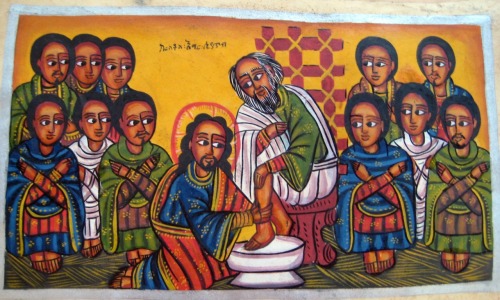Like almost any product of man, icons contain differences depending on the culture in which they were made (besides even more differences from individual artists). Thus among icons, there are different styles relating to the different cultures of origin: Greek (Byzantine), Russian, Coptic, Ethiopian, etc. Usually in my posts, I include and discuss Byzantine icons, though Russian icons are also involved often. In this post, I wish to give a brief overview of another style of icons: Ethiopian iconography.
The Ethiopian Orthodox Church began when Christianity was first widely spread to Ethiopia (discounting the Ethiopian eunuch converted by St. Philip in Acts 8) in the 5th century by a group of missionaries known now as the Nine Saints: Abba Aftse, Abba Alef, Abba Aragawi, Abba Garima (Isaac/Yeshaq), Abba Guba, Abba Liqanos, Abba Pantelewon, Abba Sehma, and Abba Yem'ata. It is conjectured that they were possibly refugees from persecutions after the Council of Chalcedon: this Council declared the two natures of Christ, human and divine, and these missionaries (like the Ethiopian Orthodox Church to this day) were Miaphysite (believers in "One United Nature": often this is confused with Monophysite, "One Single Nature," which is a term not used by this Church itself). (Just as a side note, this Miaphysitism, or Non-Chalcedonianism, is common to all Oriental Orthodox Churches: Coptic Orthodox, Ethiopian Orthodox, Eritrean Orthodox, Syriac Orthodox, Malankara Orthodox Syrian (in India), and Armenian Apostolic churches.) Christians who did not accept the definition of the Council of Chalcedon, such as the Nine Saints, were persecuted, so it is thought that they escaped to Ethiopia to free persecution. In addition to spreading Christianity in Ethiopia, some of the Saints also founded monasteries following the rule of St. Pachomius. Besides this origin and differing Christology (Miaphysitism), the Ethiopian Orthodox Church is well known for reportedly having possession of the original Ark of the Covenant built according to the commands of God given through Moses, as recorded in the Pentateuch: this Ark would contain the (second set of) tablets containing the Ten Commandments, as well as possibly other items from the time of Moses (such as manna and Aaron's staff).
Ethiopian iconography is characterized by their palette of colors (brighter colors than Byzantine iconography, and usually more colors as well), an art style that seems more rounded and less defined (one could say it looks more similar to animation than portraits, which Byzantine iconography is more similar to), the lack of a gold (or other solid, distinct color) background in general, the frequent lack of text, and painted, rather than gilded, halos (if they are present at all, which sometimes they are not). Some differing iconographic conventions compared to Byzantine iconography are depictions of the Holy Trinity (which was for a long time not allowed at all in Byzantine iconography and is still often discouraged) in the form of three identical white-haired men, seated in a row, and a change in color symbolism, such as Mary's outer garment being deep blue rather than red. Among the more favored subjects of Ethiopian iconography are the Flight from Egypt (as a reminder that Africa sheltered the Holy Family); St. George, the patron of Ethiopia, who is often seen close to Mary; Mary and the Christ Child flanked by angels; St. Michael the Archangel; the Nine Saints mentioned above, who are often depicted in a circle; various events from the lives of Mary and Jesus; and Ethiopian saints, especially Takla Haymanot from the 13th century (renowned for praying so long standing on one leg that his other leg fell off and for miraculously receiving six wings to prevent a fatal fall when a rope broke as he climbed down a mountain).
Below is a small gallery of images of Ethiopian icons:
The Trinity
The Flight from Egypt
The Flight from Egypt
St. George (though the source claims it to be St. Michael)
St. Michael
The Nine Saints
Takla Haymanot
I hope this introduction to the iconography of Ethiopia was interesting and helpful. To conclude, I'd like to ask for the intercession of a Roman Catholic Ethiopian: Bl. Ghebre Michael (1788-1855). Bl. Ghebre was a one-eyed Ethiopian Orthodox monk who eventually converted to Catholicism due to his friendship with St. Justin de Jacobis, a Vincentian missionary from Italy. After converting, being ordained a priest, and deciding to become a Vincentian, Bl. Ghebre, along with other Catholics, were arrested and tortured for not professing the Miaphysite Christology of the Ethiopian Orthodox Church. Due to the intervention of the British, Bl. Ghebre was not executed for apostasy, but he was forced to follow the army while in chains. This harsh treatment eventually lead to his death, and he was beatified as a martyr in 1926. (As an interesting fact, the picture of Bl. Ghebre below may be a drawing of him by St. Justin himself.)
Thank you for reading, and God Bless.
Bl. Ghebre Michael, pray for us!
Nota Bene: Information for this post comes from Wikipedia (Nine Saints, Ethiopian Orthodox Church, Oriental Orthodoxy), Orthodox Wiki (Takla Haymanot), the Smithsonian's National Museum of African Art, Betsy Porter, FamVin (Ghebre Michael, Justin de Jacobis) and Adigrat Eparchy.
Text ©2012
Brandon P. Otto.
Licensed via CC
BY-NC. Feel free to redistribute non-commercially, as long
as credit is given to the author.








